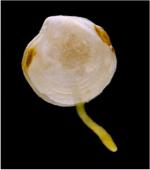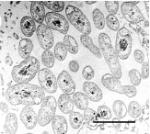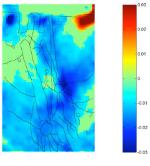Research Interests
Chemoautotrophic symbiosis in thyasirid bivalves:
Chemoautrophic symbioses are long-term associations between invertebrates and chemoautotrophic bacteria (sulphide or methane-oxidizers), with nutritional benefits for the animal host. Since the discovery of such associations at hydrothermal vents, chemosymbioses have been found in a variety of marine habitats, including shallower sediments that are enriched with organic matter. In my lab, we study chemosymbiotic bivalves of the family Thyasiridae; symbiotic thyasirids are often found as abundant, opportunistic colonists in sites of organic enrichment such as fjords, paper mill or sewage outfalls, aquaculture sites and offshore oil fields. Current reseach in my lab focuses on thyasirids from various sites in Bonne Bay, Newfoundland.
 Thyasira flexuosa
Thyasira flexuosa
Areas of focus:
1) Anatomical studies of symbiont-host relationships
Thyasirids are an interesting model of the early establishment of symbiosis, since most species maintain their symbionts outside their gill cells instead of within them. I am interested in looking at the fine-scale relationships between symbiotic players, and the flexible nature of the symbiosis as a response to environmental change. Tools generally used for this work include histology, scanning and transmission electron microscopy, and confocal scanning laser microscopy.
 TEM image of symbionts in a thyasirid gill
TEM image of symbionts in a thyasirid gill
2) Genetic studies of thyasirid populations
Phylogenetic relationships within the thyasiridae, and the degree of specificity between host and symbiont are poorly understood. Investigations of host and symbiont gene sequences can inform us on co-evolutionary patterns in this family, and give us a better idea of their potential for dispersal at various spatial scales.
3) Investigations of reproductive cycle
Very little is known on the mode of reproduction of this family of bivalves. Studies of reproductive cycles and investigations of the potential for brooding in thyasirids will help us understand how these organisms are able to form abundant populations in organic-rich patches of sediments. Also, developing laboratory cultures of thyasirids would be very useful for future investigations of how symbionts are acquired by juvenile thyasirids.
4) Behavioural studies and sedimentary impacts
Thyasirids are small (most are < 1 cm), but may have a large impact on their sedimentary environment. My previous research has shown that symbiotic thyasirids can form extensive networks of burrows in the sediment, probably to mine for the sulphides required for the metabolism of their bacterial symbionts. Investigations will focus on how thyasirid ventilation patterns and burrowing behaviours can have an impact of sediment chemistry (and eventually benthic communities). Tools such as CT-scanning, microelectrodes, and 2D optodes will be used for this research.
 pH optode image of burrowing thyasirids
pH optode image of burrowing thyasirids
Feeding adaptations in bivalves
I am generally interested in how the feeding structures (gills, labial palps, mantle) of bivalves are adapted to various environmental conditions. Using tools such as histology and scanning electron microscopy, fine-scale anatomical observations of bivalve feeding structures are made. I am particularly interested in looking at feeding structures in less known species from deep-sea or organically enriched environments.
Biogenic structures in marine sediments
Novel tools, including CT-scanning, allows us to non-destructively study biogenic structures (burrows, tubes, galleries) in sediments, helping us understand the behaviour of benthic macroorganisms and their relationship to sedimentary structure and biogeochemistry. Research in my lab uses CT-scanning along with other tools (for example, electrodes and 2D optodes) to answer questions regarding benthic macroorganisms and their biogenic structures, either in situ or in experimental microcosms.
Benthic impacts of aquaculture
It has been established that finfish aquaculture can significantly impact sediments surrounding holding pens, due to the organic enrichment caused by unused fish food, and fish feces. I am interested in using novel approaches to investigate the impacts of aquaculture on sediments, considering the entire benthic community.